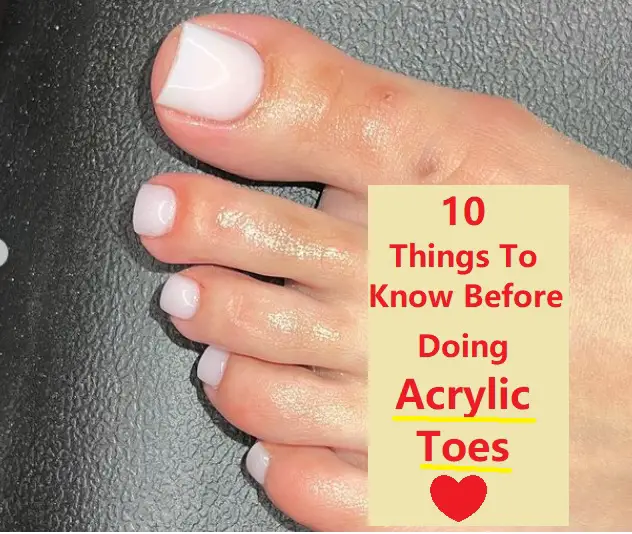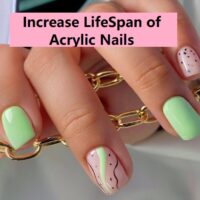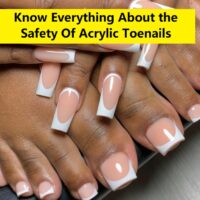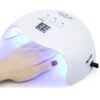A lot of women enjoy doing their toenails. It can be as straightforward as painting your nails or doing a French manicure or elaborate gel nails, acrylic nails, and tips. Although nail polish has been around for centuries, it wasn’t until recently that you could do things like add gems to your natural toenail.
As you might imagine, when applying acrylic toenails, a particular type of preparation is needed before having them applied. Many women and men choose to get acrylic toenails to make their toes look more presentable and well-groomed.
However, they often don’t know the basics of acrylic toenails or don’t consider certain things that could result in an unpleasant experience with acrylic nails.
Can I Get Acrylic Toenails?
Getting acrylic toenails is much different than getting normal fingernails. The acrylic comes in liquid form and hardens when exposed to ultraviolet light. While natural nails grow out and can be cut (hence their natural name), acrylic nails can stay on for months before you have to have them redone or removed altogether.
If you get your first set done at a salon, make sure you see a specialist with adequate nail services training before getting acrylics because they are more challenging to apply correctly than natural nails.
If you decide to do them yourself, take your time applying each layer of nail polish, and don’t rush through so that each coat dries appropriately. Keep some acetone handy if any goes astray while applying your artificial nails to help fix any boo-boos.
When removing artificial nails, use good old acetone instead of other types of nail polish remover as well; using anything other than acetone may damage your natural nails underneath.
Once you’ve had acrylics professionally done once or twice, you might not want to go back; they feel amazing! Having someone else put them on makes it easier if you find them too tricky to do by yourself, even with instructions from blogs or tips from friends who have gotten them.
10 Things To Know
So, if you wish to get your toes done with acrylic, here are ten things you should know before getting your toes done.
✔️1. Clean your toes properly. Use soap and water or soak in warm water with Epsom salts to soften any dead skin that may make adhering acrylic nails more difficult.
✔️2. Your skin also needs to be clean, so avoid body wash or other cleansers because they can clog pores.
✔️3. Get rid of strong odors on your feet, such as garlic, fish, vinegar, etc. You want to avoid stinky toes since they will probably end up smelling bad even after having artificial acrylic toenails removed once they start growing out again because of typical foot odor problems.
✔️4. Moisturize your skin between applications. Because acrylic toenails are not alive like natural fingernails and toenails, they have no oil glands to keep them moisturized. Keeping moisture in your skin between applications is vital, especially if you naturally have dry hands and feet.
✔️5. Avoid salty foods while wearing artificial fingernail tips because salt breaks down nail glue.
✔️6. Avoid hot tubs while wearing synthetic toenail extensions
✔️7. Try to not put pressure on them too much because such activities can break them
✔️8. Learn how to remove your acrylic toenails by yourself without damaging your actual nail bed
✔️9. Try not to get sick while wearing plastic tip over-nails
✔️10. Ensure you don’t do heavy housework, such as scrubbing floors with a brush. Instead, do light work so those particles don’t get into things.
Here is a lengthy summary of 10 things you should know before getting acrylic toenails:
Are Acrylic Toe Nails Safe?
There are lots of things that aren’t safe. What this means is even if a treatment is safe, it doesn’t necessarily mean it will be good for you. If there’s one thing we’ve learned about toes and feet over time, it’s that not all of them are normal.
It can make something like getting acrylic nails done on your toes—something that may seem safe at first—into something risky if you do it improperly or don’t take care of your nails afterward. So what do you need to know before doing acrylic toenails?
This question is probably one of the most important things to consider before getting acrylic toenails done. The truth is, you can’t be 100% sure that anything is 100% safe. However, you can weigh out your options and decide if they are worth your own goals.
- Firstly, there’s a reason why professionals use protective gear when performing salon services; no matter how careful someone may be, accidents happen, and it’s better to be safe than sorry when dealing with open wounds.
- Secondly, don’t think for a second that these people have been doing their job for years without ever experiencing an accident or mishap! When making such vital changes to your body (especially around your feet), it makes sense to research and learn about everything involved to protect yourself from something going wrong.
- Finally, and arguably most importantly, follow all aftercare instructions carefully. No matter what type of materials or products you use on yourself (whether they be homemade remedies or store-bought products), brushing up on aftercare information will put you in control – not only regarding safety but also comfort levels as well. Having too much moisture inside your new nails could cause pain over time while using too many harsh chemicals could further damage them!
Are Acrylic Toenails Bad?
Many people assume that acrylic toenails are nasty for you, but they aren’t actually any more dangerous than natural fingernails—you have to know what you’re doing. Firstly, get a consultation from a manicurist or an aesthetician who regularly does nail extensions.
Ask about their sterilization procedures; some places use an autoclave, which makes them even safer than going to a salon that uses traditional tools and implements. If your place isn’t certified (they should tell you), consider looking elsewhere.
At-home kits can be a good alternative if there isn’t a shop nearby, but don’t cut corners. It’s easy to transmit illnesses like hepatitis via contaminated equipment, so skip your kits clean.
Instead, find brands with glowing reviews at makeup supply stores and ensure they come with training DVDs. Remember: if your cuticles look dry or inflamed before you start (or you notice red bumps afterward), ask your manicurist about using bleach cream instead of acetone, which will irritate the sensitive skin on your toes. Lastly: filing your nails can cause infection too!
Is It Bad To Put Acrylics On Your Toenails?
So, you’re interested in trying acrylic nails. There are tons of good reasons for it! You want to add some glam to your toes and strut around town in sandals and feel pretty. There is no one standard answer to this question, as the safety and efficacy of acrylic nails depend on the type of acrylic used and the individual’s specific skin and nail type.
That said, acrylic nails are generally safe when used in a standard fashion – that is, not placed on areas that are sensitive or prone to infection and removed regularly to prevent skin dryness and cracking.
A few potential side effects of using acrylic on your toenails include allergic reactions, nail bed damage, and nail growth. In extreme cases, acrylic nails may even cause skin cancer. However, these risks are rare and typically only occur when acrylic nails are improperly applied or not removed regularly.
However, before deciding on getting acrylic toenails, there are a few things you should know about them first. Read on for some information that will help you make an informed decision about whether or not doing acrylic toenails is suitable for you.
Many people who do their manicures find that acrylics take up more time than other types of nail polish — especially if you haven’t done them before. Be sure to get everything together ahead of time (the entire process can take up to 2 hours) to avoid being rushed while doing them.
Make sure there won’t be any interruptions during each application stage, too; otherwise, they might come out looking uneven and unsightly.
So, in conclusion, while there is some risk associated with using acrylic nails, it is generally considered a safe and effective way to beautify the hands and feet.
Is It Safe To Put Acrylic On Toes?
The truth is that it is perfectly safe if you are a healthy adult with sound toenails and no history of fungal infections or disease in your feet or legs. Here’s what else you need to know about doing acrylic toenails. It is okay to do them, even if you have diabetes, but keep in mind that poor circulation can make infections in your feet more likely. So here’s how:
- Cleanse your skin with alcohol as well as under nails.
- Ensure toes/toenails are dry.
- Apply cuticle remover around the toe area (not necessary if done by a nail professional).
- Fill any gaps between and below natural nails.
- Lastly, use the curved side of the file to shape any edges or corners.
Your natural nails must grow long enough past the previous acrylic tip so they can be sealed into an arch (or platform) properly. Take care not to cut too much away-this will only weaken natural nails & result in quick decay underneath the nail plate!
Is Acrylic Bad For Your Toes?
Topcoat when it comes to acrylic toenails, many people think that because they’re already on their toes, there can’t be any harm in going even further. Unfortunately, acrylic is a tricky substance, and it can crack your nail bed if you put enough pressure on it.
Try to take care when putting on your shoes, and remember to push back your cuticles every so often; both actions put unnecessary stress on your nails, which could cause them to crack under pressure.
Be sure not to leave acrylics on for too long either; remember that your nails will grow out over time, and eventually, you’ll need a fresh set! Acrylic may seem like an excellent short-term solution to stronger nails and longer-lasting polish. Still, there are multiple reasons why you shouldn’t permanently commit to doing acrylics at home.
If you must continue getting professional sets, consider getting weaker acrylic or gel polishes so that all your effort isn’t in vain. Plus, don’t forget about tip designs-the angle of a rounded tip can hurt easily against your skin if you’re wearing thick topcoat polish or regular nails with large tips.
You might want to keep a metal file handy or get into the habit of using tape or gel between layers—it’s better than risking hurting yourself just by walking around town!
Can Acrylic Toenails Cause Fungus?
Acrylic toenails causing fungus infection are potential side effects of long-term nail treatments. The acrylic material will trap moisture, ideal for the fungus to grow. Fungi can quickly spread from your hands to your feet—and vice versa—so it’s essential to practice good hand hygiene when wearing artificial nails.
If you develop a fungal infection, visit your podiatrist for a prescription treatment (such as an oral antifungal).
Early on, treating a fungal infection can significantly reduce its symptoms and associated risks. Podiatrists are trained in foot surgery and nail care, so there’s no better doctor for someone experiencing bothersome nails.
They’ll be able to tell if you have a fungus under your nails or if there are other reasons behind your nail problems (which require different treatments).
Do Acrylic Toe Nails Hurt?
Getting acrylic toenails can be a nerve-wracking experience for some people. While it is true that it does hurt a little bit, many people find that they feel much better once they get through it.
There are several methods of getting acrylic toenails to make them less painful, such as mixing sugar or baking soda into your material to soften your toes. It can ease discomfort from the chipping and peeling of the natural toenail. So if you’re interested in having some acrylic nail work done on your toes, follow these steps to make sure you’re ready for them.
- Make sure you’re not allergic before you even think about getting acrylics
- Talk with your nail technician beforehand
- Be prepared, especially if this will be a process that requires multiple visits.
- Make sure you know what type of finish looks best on you
Can Acrylic Help Ingrown Toenails?
In some cases, yes. The consistency of acrylic toenails can help eliminate pressure caused by a shoe rubbing against an ingrown toenail. Have your acrylic nail technician file down any parts of your nail hanging over, so it’s even with your natural nail. It is usually enough to relieve pressure and allow your toe to heal.
In most cases, though, you won’t be able to get rid of an ingrown toenail if you have long toes or an abnormal growth pattern. These are best treated by a podiatrist who can provide additional pain relief and solutions for fixing it permanently—and sometimes, surgery may be necessary.
Avoid putting shoes on until after doing some light exercise. Ingrown toenails commonly occur because a shoe doesn’t fit properly. If you notice discomfort when putting on new shoes, take them off immediately and use ice and anti-inflammatory medication until they feel better. Put on socks to keep your feet from swelling; consider getting a wide size for larger feet that don’t fit in standard sizes.
How Are Acrylic Nails Done?
Each of these materials is important in different ways, so let’s break them down.
- Start with a base coat: your acrylic nails need to be clean before doing anything else. It’s also helpful to give your nails some time to soak in water if they aren’t used to it; soaking makes them softer and easier to work with. Letting them dry out after doing acrylic nail tips is helpful, too—soak them overnight if possible!
- Once they’re dry, put on one thinner layer of clear polish, and then use an orange stick (or pincher) to push back your cuticles. Make sure that all ten toenails are cleaned at once for consistency.
- To ensure that you can see what you’re doing when applying nail tips or sculpting and working with acrylic powder or gel directly on your nail bed (if doing a French manicure), keep cotton balls handy.
- While dipping each toe into whitener might seem sensible, it wastes much of your product; instead, wipe individual toes against strips cut from cotton balls soaked in whitener.
How Do Acrylic Nails Work?
Acrylic nails come from a mixture of synthetic resin (methacrylate) and monomers applied to a nail, which then hardens with UV light. The resin makes up 95% of acrylics, while only 5% is a monomer.
The resulting material hardens into a gel-like substance which provides strength and flexibility to nails. Since you’re applying it to your nails, you control everything from length to shape — even color.
It also means you don’t have to worry about having someone else make or ruin your nails since you can design them yourself. You can even add special effects like ridges or shimmery effects for any occasion that requires some bling on your toes. Do not use polish remover to take off acrylics. It will cause irreparable damage to your nails. Always use acetone-free remover specifically designed for removing acrylics.
How Are Acrylic Nails Made?
All types of acrylic nails combine a powder, liquid monomer, and either an activator or catalyst. The monomer is a chemical that softens when mixed with other chemicals, while an activator causes those chemicals to become active. A catalyst speeds up a reaction (in case you were wondering).
Once mixed, the resulting goo is applied to natural nails in layers and then formed into shape using UV light. Regular manicures can typically last two weeks without any upkeep or damage, but acrylic nails usually last about two months before needing maintenance. If you get them professionally done regularly, that timeframe could extend to over six months!
How Are Acrylic Nails Removed?
Now that you’ve got acrylic nails, it’s time to decide how long you want them to last. If you want to keep them for a full two weeks, keep in mind that they have to be removed with nail polish remover—which can sometimes be harsh on your nails.
If you want to take them off yourself, always use acetone-free remover so that your nails don’t get brittle or damaged. Otherwise, if you can find a salon near where you live that offers pedicures and manicures (or even just acrylic nails), they should be able to remove your design without damaging your natural nails.
Or, if you feel like splurging, go ahead and get them done professionally; at most salons, it should cost around $15 to $20 extra. No matter what route you go with, make sure to soak your feet first: The longer and more thoroughly your soak your feet beforehand, the easier it will be for someone else to cleanly pry off your nails later.
How Should Acrylic Nails Look?
In general, acrylic nails should look natural. You shouldn’t be able to tell if your nails are fake, just that they look good. However, you can use tips and other methods to get a more detailed look, such as nail art or artificial gems. Sometimes these methods can make your nails seem a little more fake, but they are still much more appealing than unadorned acrylics that don’t look like natural nails at all.
Ultimately, it is up to you to try something different or keep things simple with acrylic pedicure ideas for short nails. Remember, though, that less isn’t always more—the quality of materials used matters far more than how many tricks you incorporate into one design.
While an intricate design may seem complex, most artists will admit that those take far longer to complete than basic ones do. So don’t fret over having too few designs; remember that in most cases, less is more when making your nails look unique while remaining elegant and beautiful.
Conclusion
Finally, be careful with those tweezers and try not to put too much pressure on your nails. If you can, let someone else do your toes! While acrylic toenails are a fun activity for girls of all ages, make sure you know what you’re doing before attempting it. These tips should help give you a basic understanding of how to do acrylic nails so that you can have them looking great for as long as possible! Should you decide to try acrylic toenails, make sure to do some research first? All of these tips should help you get through your experience as stress-free as possible. Good luck!









